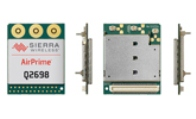
The Q2698 is programmable, which will enable the development of embedded M2M applications with the Sierra Wireless Open AT Application Framework. This means that customers already using AirPrime Q series modules will be able to migrate from 2G to 3G, using the same hardware platform design and embedded applications they had developed for earlier products.
Commenting Didier Dutronc, Senior Vice President, M2M Embedded Solutions for Sierra Wireless aid, “The AirPrime Q2698 is designed for customers seeking an M2M embedded module that can provide 3G cellular network connectivity in any international location. Because it also offers the Open AT Application Framework, embedded applications using the new AirPrime Q2698 module can be customised to meet business-specific M2M service needs.”
With a seven year track record and millions of units already deployed in the field, the AirPrime Q Series matches the requirements of machine-to-machine (M2M) applications in terms of both durability and longevity. The Q2698, which will begin shipping in the second half of 2012, can be used in a wide variety of fixed or mobile M2M deployments in segments such as industrial, energy, sales and payment, transportation, or healthcare. It provides network access nearly anywhere in the world, including Australia, North America, Europe, Middle East, Africa, Latin America, China, and Japan.
The AirPrime Q2698 module includes GPS technology, which is essential to fleet management, asset tracking, and other location-based applications. It also features best-in-class analogue and digital audio capabilities and a large set of interfaces to ease integration.
The AirPrime Q2698 module simplifies the development of M2M applications, thanks to the industry-proven Sierra Wireless Open AT Application Framework. Open AT allows developers to access the powerful processor of the Q2698 and embed their application software within the wireless module, which eliminates the need for external runtime units to perform logic functions. The result is faster time to market and reduced overall system cost.
The Framework uses industry-standard C language programming, streamlining software development and it includes a comprehensive set of software libraries and a powerful, easy-to-use integrated development environment, the Sierra Wireless Developer Studio.
 CIE Components in Electronics
CIE Components in Electronics



